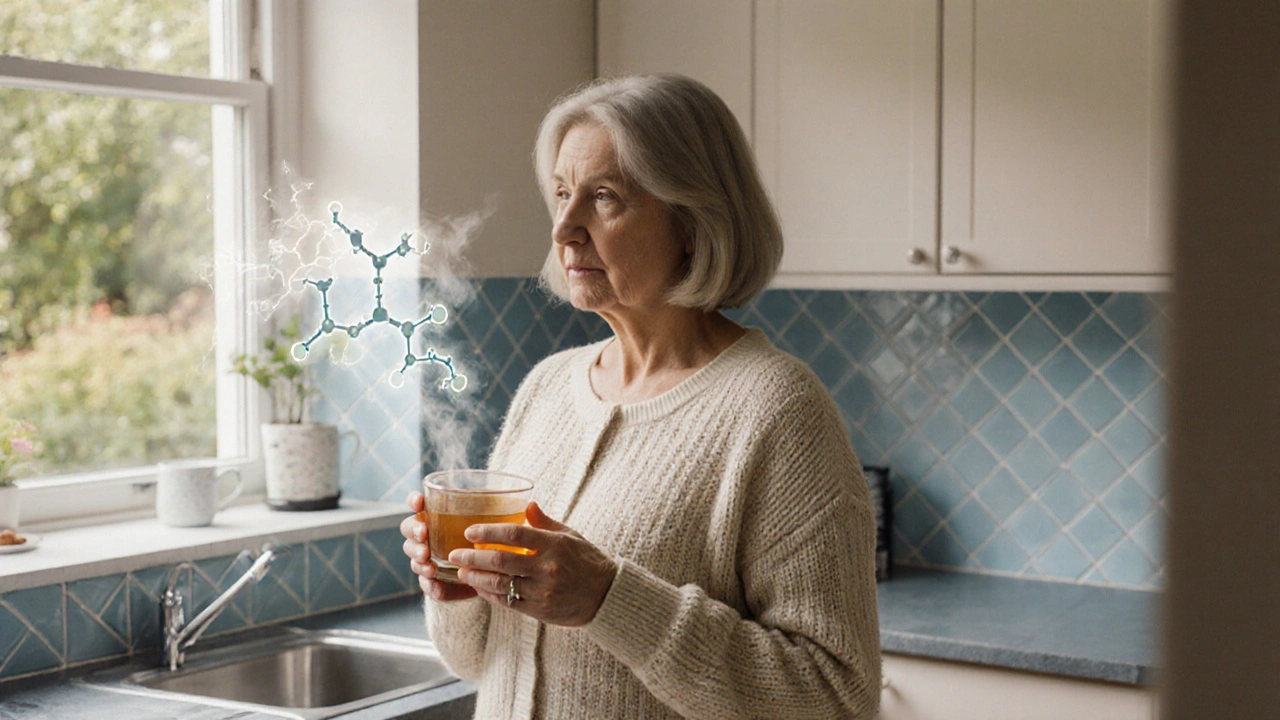Quick Take
- Hyperprolactinaemia is excess prolactin from the pituitary.
- Insulin resistance means cells don’t respond well to insulin.
- High prolactin can interfere with insulin signalling through dopamine pathways.
- Women with PCOS, men on certain meds, and people with obesity often show both conditions.
- Treating prolactin excess (e.g., cabergoline) often improves glucose control.
What Is Hyperprolactinaemia?
Hyperprolactinaemia is a condition where the pituitary gland releases excess prolactin, the hormone best known for stimulating milk production after childbirth. In everyday life, you might notice irregular periods, unwanted breast discharge, or reduced libido. Even if you’re not pregnant or nursing, a lingering prolactin surge can throw off the whole hormonal orchestra.
Understanding Insulin Resistance
Insulin resistance describes a state where muscle, fat, and liver cells fail to respond properly to insulin, the hormone that shuttles glucose from the bloodstream into cells. The pancreas compensates by pumping out more insulin, which over time can lead to type2 diabetes, weight gain, and the broader metabolic‑syndrome picture.
Hormonal Crosstalk: How Prolactin Affects Insulin
At first glance, prolactin and insulin seem to live in separate worlds-one rules lactation, the other manages sugar. The bridge between them is dopamine.
Dopamine is a neurotransmitter that normally keeps prolactin levels in check by inhibiting the pituitary lactotroph cells. When prolactin climbs, dopamine pathways get throttled, and the same dopamine receptors on peripheral tissues become less responsive to insulin. In plain English: too much prolactin can blunt the body’s insulin‑boosting signal.
Animal studies from 2023 show that rats with induced hyperprolactinaemia develop higher fasting glucose and a 20% drop in insulin‑stimulated glucose uptake. Human data echo this-women with unexplained hyperprolactinaemia often have higher HOMA‑IR scores (a measure of insulin resistance) than age‑matched controls.
Clinical Overlap: Who Gets Both?
Several groups are prone to the double‑hit of high prolactin and poor insulin sensitivity:
- Polycystic ovary syndrome (PCOS) - a classic metabolic‑endocrine disorder where elevated prolactin can worsen ovarian androgen production and insulin resistance.
- People taking antipsychotics or certain prokinetic drugs (e.g., risperidone, domperidone) that raise prolactin as a side effect.
- Individuals with obesity, especially visceral fat, because adipose tissue releases cytokines that both raise prolactin and impair insulin signalling.
- Men with hypogonadism - low testosterone often pairs with high prolactin, leading to a metabolic slowdown.

Diagnosis: Spotting the Connection
The first step is a simple blood test. A fasting prolactin level above 25ng/mL (women) or 20ng/mL (men) flags hyperprolactinaemia. For insulin resistance, clinicians look at fasting glucose, fasting insulin, and calculate the HOMA‑IR index.
Because the two conditions share symptoms-weight gain, fatigue, menstrual irregularities-doctors often order a combined panel:
- Serum prolactin.
- Fasting glucose and insulin.
- Lipid profile (to assess metabolic‑syndrome risk).
- Thyroid‑stimulating hormone (TSH) - low thyroid can also boost prolactin.
If imaging is needed, a pituitary MRI can rule out a prolactinoma (a benign tumor that secretes prolactin).
Managing the Dual Issue
Targeting prolactin often improves insulin sensitivity, and vice‑versa. Here’s a practical roadmap:
- Pharmacological reset - Cabergoline is a dopamine‑agonist that lowers prolactin levels in 80% of patients within weeks. Studies in 2024 show a concurrent 15% reduction in HOMA‑IR after three months of therapy.
- Metformin - the go‑to insulin‑sensitiser can also modestly lower prolactin in women with PCOS.
- Lifestyle overhaul - steady aerobic exercise (150min/week) boosts dopamine receptors and improves glucose uptake.
- Weight management - losing 5-10% of body weight often normalises both hormones.
- Stress control - chronic stress spikes cortisol, which indirectly raises prolactin. Mind‑body practices like yoga or meditation can keep both axes in balance.
Key Overlapping Features
| Feature | Hyperprolactinaemia | Insulin Resistance |
|---|---|---|
| Weight gain | Yes, especially central adiposity | Yes, due to impaired fatty‑acid metabolism |
| Fatigue | Common, linked to low dopamine | Frequent, from glucose fluctuations |
| Reproductive changes | Irregular periods, galactorrhoea | Polycystic ovary syndrome, decreased libido |
| Cardiovascular risk | Elevated via lipid alterations | High - a core component of metabolic syndrome |
Lifestyle Tips That Help Both Conditions
Even if you’re waiting for a prescription, daily habits can tilt the scales:
- Prioritise protein - 20‑30g per meal stabilises blood sugar and curbs prolactin spikes caused by low‑carb diets.
- Include fermented foods - kefir, kimchi, and yogurt improve gut microbiota, which recent 2022 research links to lower prolactin secretion.
- Stay hydrated - dehydration can raise cortisol, indirectly nudging prolactin up.
- Sleep 7‑9hours - deep sleep restores dopamine balance, keeping prolactin in check.
- Limit alcohol - excess alcohol raises both estrogen and prolactin, worsening insulin resistance.
Combine these with regular check‑ups, and you’ll have a clear roadmap to bring both hormones back into harmony.
Frequently Asked Questions
Can high prolactin cause type2 diabetes?
Elevated prolactin can worsen insulin resistance, a key driver of type2 diabetes. While prolactin alone rarely triggers diabetes, it speeds up the path to it when combined with obesity or a sedentary lifestyle.
Do dopamine‑agonist drugs lower blood sugar?
Yes. Cabergoline and bromocriptine not only drop prolactin but also improve glucose tolerance in many patients. Bromocriptine even has an FDA‑approved label for type2 diabetes.
Is hyperprolactinaemia dangerous for men?
Men can experience reduced testosterone, erectile dysfunction, and a higher risk of metabolic syndrome. Treating the prolactin excess often restores hormonal balance and improves energy levels.
How long before prolactin‑lowering meds affect insulin?
Most patients notice a drop in prolactin within 2‑4weeks. Improvements in insulin sensitivity usually appear after 8‑12weeks of consistent dosing.
Can diet alone fix both problems?
Diet is a powerful tool, especially weight loss, but most cases benefit from a combined approach-medical treatment, exercise, and stress management together give the best results.
Bottom line: hyperprolactinaemia and insulin resistance are more intertwined than you’d think. By spotting the hormonal cross‑talk early, you can tackle both issues before they snowball into full‑blown metabolic disease.

Ajay Kumar
Thanks for pulling this together – I’ve dealt with a few patients who were surprised to learn that high prolactin could mess with insulin. It really helps to have the dopamine link spelled out so we can think about meds and lifestyle together.
Pramod Hingmang
Wow, never thought prolactin was a secret player in the sugar game – you just connected the dots between dopamine and insulin resistance and it clicks.
Rebecca Ebstein
This is so helpful I cant wait to try it!
Artie Alex
While the overview is commendable, one must scrutinize the mechanistic pathways beyond mere dopamine antagonism. The interplay of PI3K/Akt signaling in peripheral tissues under hyperprolactinaemic conditions warrants deeper exploration. Moreover, the cited animal models lack translational fidelity due to species‑specific receptor isoforms. A robust meta‑analysis incorporating randomized controlled trials of cabergoline versus bromocriptine would substantiate the clinical extrapolation. In essence, the article skims over the intracellular phosphorylation cascades that ultimately dictate glucose uptake.
abigail loterina
Great rundown – I especially like the practical diet tips you listed. They’re easy to remember and can really make a difference for anyone juggling both issues.
Krishna Garimella
Reading through this piece reminded me how interconnected our endocrine system truly is, and that treating one hormone imbalance often ripples into others.
In my own experience as a fitness coach, I’ve seen clients with unexplained weight gain suddenly improve after a prolactin check.
The dopamine‑prolactin axis is a classic feedback loop, yet many clinicians still overlook its impact on insulin signaling.
When prolactin spikes, it not only dampens dopamine’s inhibitory effect but also desensitizes peripheral dopamine receptors that modulate glucose transport.
That desensitization translates to reduced GLUT4 translocation in muscle cells, which is a cornerstone of insulin resistance.
Animal studies from 2023 you referenced nicely illustrate this, showing a 20 % drop in glucose uptake with induced hyperprolactinaemia.
Human data, especially in women with PCOS, echo the same pattern, with higher HOMA‑IR scores correlating with elevated prolactin.
What I find fascinating is how medications like cabergoline can reverse both hormonal disturbances within a few weeks.
This dual benefit underscores the importance of a comprehensive lab panel rather than a siloed approach.
Lifestyle interventions, particularly regular aerobic exercise, boost central dopamine tone, which in turn keeps prolactin at bay.
Simultaneously, exercise enhances insulin sensitivity through AMPK activation, hitting the problem from two sides.
Weight loss of even modest magnitude-say 5 % of body weight-has been shown to normalize prolactin levels in obese individuals.
Stress management should not be ignored either; chronic cortisol elevation can aggravate both prolactin and insulin resistance.
Incorporating mindfulness or yoga can therefore be a low‑cost adjunct to pharmacotherapy.
Overall, the take‑home message is clear: a holistic strategy that includes hormonal testing, medication, diet, exercise, and stress reduction offers the best chance of breaking the vicious cycle.
I’ll be sharing this article with my clients and encouraging them to discuss prolactin screening with their doctors.
nalina Rajkumar
Super helpful! 😊 Definitely going to add more protein and fermented foods to my meals.
Michael Barrett
Interesting, the link between prolactin and insulin, it's clear that dopamine plays a role, and that lifestyle changes can help, also medication like cabergoline works well, but we need more long‑term data, still, it's a solid start
Inma Sims
Oh, wonderful, another article telling us that hormones are a web – as if we didn’t already know our bodies were complicated machines.
Gavin Potenza
Indeed, the notion that a single hormone can orchestrate such a cascade invites us to reconsider reductionist models; in lay terms, it’s like pulling one string and the whole puppet moves. Accepting this complexity helps us design smarter interventions.
Virat Mishra
Feels like a rehash of old stuff.
Daisy Aguirre
Actually, I think the blend of science and everyday tips makes this piece stand out – it’s both informative and actionable, which is rare.
Natalie Kelly
Good summary, thanks.
Tiffany Clarke
Clear and useful.
Sandy Gold
While the article paints cabergoline as a miracle fix, one must remember that dopamine agonists carry their own risk profile, including valvular heart issues in rare cases. Moreover, relying solely on medication ignores the socioeconomic barriers many patients face when accessing endocrinology care. A broader public‑health approach that emphasizes diet, exercise, and mental health support could mitigate the need for pharmaceutical intervention in many scenarios. The piece could benefit from a more critical lens on the cost‑effectiveness of long‑term dopamine agonist therapy. In short, hormone balance is important, but it shouldn’t become an excuse to prescribe expensive drugs without robust evidence.